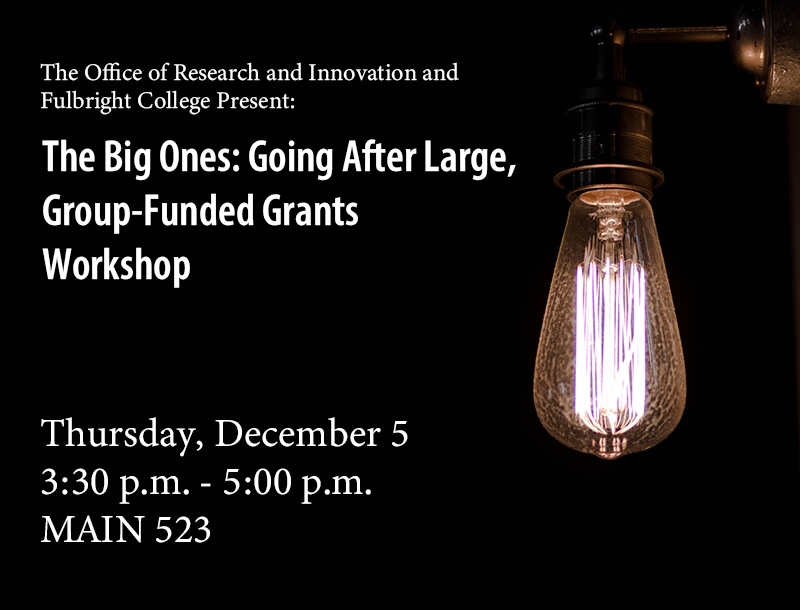
The Office of Research and Innovation and the J. William Fulbright College of Arts and Sciences will host a grant writing workshop, The Big Ones: Going After Large, Group-Funded Grants, about applying for some of the largest group projects and funding for instrumentation and research.
The workshop will be at 3:30 p.m. Thursday, Dec. 5 in Old Main 523. It is is free and open to all University of Arkansas faculty, but seating is limited to 30 participants.
RSVPs are required before 5 p.m. Wednesday, Nov. 27, by emailing Debbie Power at dlpower@uark.edu.
"We hope to increase the number of big applications that leave our campus and are highly competitive," said Jeannine Durdik, associate dean of Fulbright College. "This workshop is interdisciplinary by design, bringing together researchers from across the U of A campus to share their ideas and strategies."
Durdik said the U of A has previously secured large, interdisciplinary and multi-university collaborative grants, such as two past National Institutes of Health Centers of Biomedical Research Excellence Awards for $10 million each.
"That has had a huge impact on our campus, because big money can be used in so many ways - for new hires, new instruments, stronger collaborations and connections to each other's work," she said. "It allows us to trail blaze."
The Big Ones will feature scholars from a range of disciplines who have extensive experience in applying for federal, state and foundation support for their projects.
Featured scholars will include U of A's Hugh Churchill, Lauren Greenlee and Jeyam Subbiah, along with scholars from across campus who will participate in this interactive session.
ABOUT THE SPEAKERS
Hugh Churchill
Assistant Professor of Physics in the J. William Fulbright College of Arts and Sciences
Churchill's research group combines physics, materials science, and electrical engineering to fabricate and measure nanoscale electronic and optoelectronic quantum devices. Quantum devices have properties that are enabled or enhanced by quantum effects, either by material design, nanostructuring, or both. Current research interests include the development of novel quantum bits based on spin and valley degrees of freedom as well as unconventional magnetic, topological, and optoelectronic properties of one-dimensional and two-dimensional layered materials. Churchill also recently helped lead the creation of a large interdisciplinary proposal that was submitted last year to the National Science Foundation's new program to create Foundries for Quantum Materials Science, Engineering and Information.
Lauren Greenlee
Associate Professor and Ralph E. Martin Leadership Chair in Chemical Engineering in the College of Engineering
Greenlee's research group is interested in the development and characterization of nanoparticles and nanostructured materials for water treatment, electrochemical energy conversion, resource recovery and chemical conversion applications. Greelee's group's research is at the intersection of water chemistry, electrochemistry and nanomaterials, and focuses on solving current problems that bridge water quality, nutrient management, and electrochemical energy conversion within the wastewater treatment, agricultural and energy sectors. The group pursues a blend of fundamental and applied research projects to understand how materials chemistry and water chemistry impact engineering solutions. Greenlee's research includes the synthesis, characterization and testing of non-precious metal and metal oxide nanocatalysts, as well as electrochemical engineering and reactor/system design. Greenlee, through her startup company CatalyzeH2O, LLC, recently partnered on an interdisciplinary U.S. Army Small Business Innovation Research Program (SBIR) grant on nanoporous materials for water purification.
Jeyam Subbiah
Professor and Department Head of the Department of Food Science in the Dale Bumpers College of Agricultural, Food and Life Sciences and University of Arkansas System Division of Agriculture.
Subbiah's research interests include advanced food manufacturing, food safety engineering, multiphysics modeling of food processes for improving food quality and safety, instrumentation for food quality, and food-energy-water nexus. He was part of the $25 million grant from the United States Department of Agriculture (USDA) National Institute of Food and Agriculture (NIFA) on improving beef safety. Subbiah is also part of an interdisciplinary team that has received an $4.7 million USDA NIFA Coordinated Agriculture Project (CAP) grant to enhance low-moisture food safety by development, implementation, and validation of pasteurization technologies. In collaboration with University of Nebraska-Lincoln, Georgia Tech, and Navajo Technical University, his NSF Engineering Research Center Proposal on Center for Advanced Food Engineering and Manufacturing (CAFE) has been invited for Blue Ribbon Panel presentation.
The Big Ones: Going After Large, Group-Funded Grants workshop is part of a series of faculty workshops planned for the 2019-2020 academic year.
The presentation will include a Q & A session and is designed to benefit faculty both in the near and far future of their research endeavors.
Topics
Contacts
Jeannine M. Durdik, associate dean and professor
J. William Fulbright College of Arts and Sciences
479-575-3684, jdurdik@uark.edu
Andra Liwag, director of communications
J. William Fulbright College of Arts and Sciences
479-575-4393, liwag@uark.edu